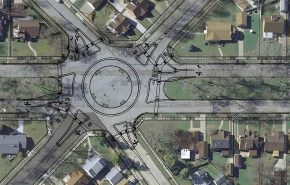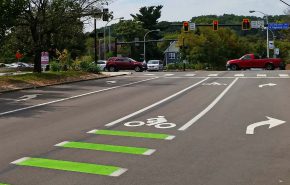Maintaining traffic flow as they reduce speeds and conflict points, roundabouts are increasingly becoming the smart intersection solution. GAI Transportation engineer Richard Krajcovic Jr., PE, PTOE, MBA discusses the many benefits that are spurring roundabouts’ growing utilization.
Roundabouts Boost Safety in Pennsylvania and Beyond
Recent data published by the Pennsylvania Department of Transportation (PennDOT) shows a significant decrease in crashes, injuries, and fatalities at intersections in the state where roundabouts have been installed. “PennDOT is now requiring that roundabout alternatives be included in every intersection study we perform for the agency for which roundabouts are feasible,” said GAI Engineering Director Richard Krajcovic Jr., PE, PTOE, MBA. “It’s great that PennDOT is moving in this direction—this innovative approach is bound to have a growing positive effect on driver and pedestrian safety throughout the state.”
NEWSCAST VIDEO
A WPMT Fox 43 report on the roundabout study includes comments from PennDOT Safety Press Officer Fritzi Schreffler.
Compelling Data Supports Benefits
Data collected from 11 intersections included in the PennDOT study reveal a 47-percent reduction in the total number of vehicle collisions and a 100-percent decrease in fatalities and serious injuries. “Safety benefits like these are also reflected in data on roundabouts from sites nationwide compiled by the Insurance Institute for Highway Safety/Highway Loss Data Institute,” said Krajcovic.
Increased Safety for Drivers and Pedestrians
“Speed reduction is probably the key safety feature of roundabouts,” said Krajcovic. “As the driver needs to slow when entering the roundabout, they have more time to make decisions: can I enter traffic, or do I have to stop and wait for an opening?” That speed reduction also helps lessen the severity of an accident should one occur—a significant contributing factor to the reduction in serious injuries and fatalities.
Roundabouts also simplify the driver’s decision-making process. “In traditional intersections, drivers may have to judge traffic coming from many directions,” said Krajcovic. “In a roundabout, the driver only has to look in one direction—to the left in the U.S.—in order to determine if they can proceed.”
Roundabouts boost safety for pedestrians as well as motorists. “To help simplify the drivers’ decision-making process, we locate pedestrian crosswalks a few car lengths before the roundabout entry point,” said Krajcovic. “That way, pedestrians become the sole priority at the crosswalk location and drivers can concentrate strictly on other vehicles as they enter traffic.”
Simplified Maintenance
“Safety is always the number one concern, yet roundabouts have the additional benefit of being relatively low maintenance,” said Krajcovic. “Roundabouts are non-signalized by and large, which reduces the need to allocate funds and personnel for signal upkeep. Once they are installed, the only maintenance most roundabouts require is occasional landscaping.”
Flexibility Tailored to Traffic Flow
While roundabouts are generally held to best accommodate traffic flow up to 20,000 vehicles per day, their capacity can be increased with some simple modification. “If you have a situation in which traffic flow is heavy or dominant from one direction, it may cause delays at a given roundabout entrance point as drivers will not be able to join the flow of traffic—and as roundabouts are traditionally non-signalized, there is no way to create traffic gaps,” said Krajcovic. “In these instances, we’ve added a ‘metering signal’ featuring automated traffic detection that can regulate heavy or dominant traffic and give all drivers the chance to enter the roundabout.” This solution allows the roundabout to compensate for intermittent traffic increases and retain its ‘free-flowing’ attributes during less heavily traveled hours.
“The use of roundabouts has increased exponentially—as the data shows, the trend is going a long way toward improving safety.”
Smart Solutions, Safer Intersections
“As in any intersection situation, there may be multiple solutions—and as engineers we evaluate the positives and negatives of each strategy to come up with the option that will best serve the desired outcomes,” said Krajcovic. “I’ve been monitoring trends over the last 20 or so years, and the use of roundabouts has increased exponentially over that time—as the data shows, the trend is going a long way toward improving safety.”
Read more about GAI’s work with roundabouts and other intersection solutions:
- Peanut Roundabout Cracks Traffic Safety Challenge
- The Circular Logic of Roundabouts
- Traffic Engineering Transforms Busy Intersection
Contact Richard Krajcovic Jr., PE, PTOE, MBA, 412.399.5186, for more information about GAI’s transportation and traffic engineering services.
![]() Richard Krajcovic Jr., PE, PTOE, MBA specializes in transportation and traffic engineering analysis and design. Rich has extensive experience with public and private transportation projects, including agency coordination, bicycle and pedestrian accommodations, transportation impact studies, transit oriented development planning, and more.
Richard Krajcovic Jr., PE, PTOE, MBA specializes in transportation and traffic engineering analysis and design. Rich has extensive experience with public and private transportation projects, including agency coordination, bicycle and pedestrian accommodations, transportation impact studies, transit oriented development planning, and more.



